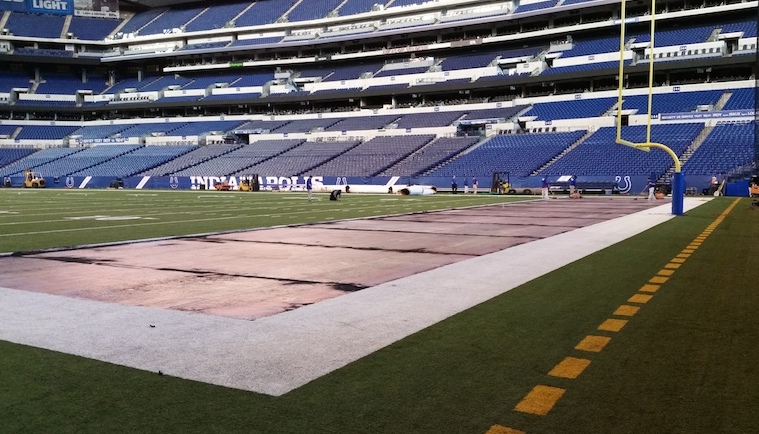Erik Harlow, the Lucas Oil Stadium turf manager famous for repairing a seam in the middle of last year’s Big Ten championship game, told SportsTurf that the Colts chose to have convertible end zone panels made because paint was not holding well on the fibers of the initially installed synthetic turf.
“So we had blank green panels made and converted the system,” Harlow said. “It’s not a cheap process but if your facility has the money it is a very nice option.”
Harlow said the process time of switching out the panels varies depending on how many panels are being replaced and how much labor is available. When we spoke, Lucas Oil’s surface was being replaced (FieldTurf out, Shaw Sports Turf in, with The Motz Group handling the installation); Harlow said he hopes installation time for the new system’s panels will be 12-15 hours for both end zones.
The panels are secured by heavy-duty Velcro along their edges, which can be unzipped before the panels are rolled up, a pipe put through the center, and then taken away via picker. “Having a proper rack or cradle for storing panels is important,” Harlow said. “Being rolled up keeps the infill in the panels; when you go to put them down again, you only have to refill along the edges.
“The synthetic turf manufacturers build the panels and all have crews who do the switch outs; I will call about 2 months in advance to schedule their 5-6 person crew. And then when they are here we supply more labor,” he said.
“The process is pretty cut and dried and we’ve had great success. When the panels are properly installed, you can’t tell the difference,” Harlow said.
Harlow said he likes to make the conversion about a week before a special event like the Big Ten championship game, to give the new paint time to dry before pre-game media events, etc.
The seams are secured by having the “loop” part of the Velcro sewn onto the bottom of each panel, and the “hook” part on a wide strip that lays on the ground, by zippering them together they adhere to the ground, and then infill is used to fill in that seam, Harlow said.
Storing the panels properly is very important to making the process go smoothly, Harlow said. “You don’t want the panels laying flat, and you don’t want to roll them until they are completely dry after the paint is removed,” he said. “The tighter you can roll them, the less infill you’ll lose.
“Keep a close watch on the Velcro; it can become contaminated with paint and infill, especially the male Velcro on the bottom,” he said. “You also need to watch that any equipment you are using doesn’t somehow compromise the integrity of the Velcro. Stay off the edges, and especially when there are no panels in place, limit any equipment being on those edges. If you keep them firm and clean there will be less infill in the Velcro.”
Harlow said if a turf manager is able to be part of the process from the beginning, he or she should ask the panels be designed to that as many seams as possible fall outside the hash marks, which will limit possible problems.
“Go with a company that has experience installing quality surfaces, and someone you are personally comfortable working with,” he added.


